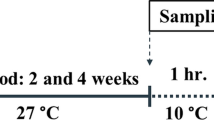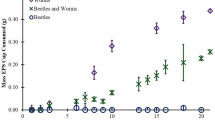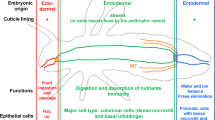Abstract
Silkworm (Bombyx mori), a model Lepidoptera insect, is economically important. Its growth and development are regulated by endogenous hormones. During the process of transition from larvae to pupae, 20-hydroxyecdysone (20E) plays an important role. The recent surge in consumer products and applications using metallic nanoparticles has increased the possibility of human or ecosystem exposure due to their unintentional release into the environment. We investigated the effects of exposure to titanium dioxide nanoparticles (TiO2 NPs) on the action of 20E in B. mori. Titanium dioxide nanoparticle treatment shortened the molting duration by 8 hr and prolonged the molting peak period by 10 %. Solexa sequencing profiled the changes in gene expression in the brain of fifth-instar B. mori in response to TiO2NPS exposure for 72 hr, to address the effects on hormone metabolism and regulation. Thirty one genes were differentially expressed. The transcriptional levels of pi3k and P70S6K, which are involved in the target of the rapamycin (TOR) signaling pathway, were up-regulated. Transcriptional levels of four cytochrome P450 genes, which are involved in 20E biosynthesis, at different developmental stages (48, 96, 144, and 192 hr) at 5th instars of all displayed trends of increasing expression. Simultaneously, the ecdysterone receptors, also displayed increasing trends. The 20E titers at four developmental stages during the 5th instar were 1.26, 1.23, 1.72, and 2.16 fold higher, respectively, than the control group. These results indicate that feeding B. mori with TiO2 NPs stimulates 20E biosynthesis, shortens the developmental progression, and reduces the duration of molting. Thus, application of TiO2 NPs is of high significance for saving the labor force in sericulture, and our research provides a reference for the ecological problems in the field of Lepidoptera exposured to titanium dioxide nanoparticles.







Similar content being viewed by others
References
Arbeitman MN, Hogness DS (2000) Molecular chaperones activate the Drosophila ecdysone receptor, an RXR heterodimer. Cell 101:67–77
Audic S, Claverie JM (1997) The significance of digital gene expression profiles. Genome Res 7:986–995
Bennett ST, Barnes C, Cox A, Davies L, Brown C (2005) Toward the 1000 dollars human genome. Pharmacogenomics 6:373–382
Bergé JB, Feyereisen R, Amichot M (1998) Cytochrome P450 monooxygenases and insecticide resistance in insects. Philos Trans R Soc Lond B Biol Sci 353:1701–5
Buszczak M, Segraves WA (2000) Insect metamorphosis, out with the old, in with the new. Curr Biol 10:R830–3
Cheng DJ, Xia QY, Zhao P (2006) EST-based profiling and comparison of gene expression in the silkworm fat body during metamorphosis. Arch Insect Biochem Physiol 61:10–23
Choi H, Stathatos E, Dionysiou DD (2006) Sol–gel preparation of mesoporous photocatalytic TiO2 films and TiO2/Al2O3 composite membranes for environmental applications. Appl Catal B Environ 63:60–67
Dubrovsky EB (2005) Hormonal cross talk in insect development. Trends Endocrinol Metab 16:6–11
Esterkin CR, Negro AC, Alfano OM, Cassano AE (2005) Air pollution remediation in a fixed bed photocatalytic reactor coated with TiO2. AIChE J 51:2298–2310
Fabian E, Landsiedel R, Ma-Hock L, Wiench K, Wohlleben W, van Ravenzwaay B (2008) Tissue distribution and toxicity of intravenously administered titanium dioxide nanoparticles in rats. Arch Toxicol 82:151–157
Fisher J, Egerton T (2001) Kirk–Othmer encyclopedia of chemical technology. John Wiley, New York
Gilbert LI, Warren JT (2005) A molecular genetic approach to the biosynthesis of the insect steroid molting hormone. Vitam Horm 73:31–57
Gu SH, Yeh WL, Young SC, Lin PL, Li S (2012) TOR signaling is involved in PTTH-stimulated ecdysteroidogenesis by prothoracic glands in the silkworm, Bombyx mori. Insect Biochem Mol Biol 42:296–303
Gu ZY, Zhou YJ, Xie Y, Li FC, Ma L, Sun SS, Wu Y, Wang BB, Wang JM, Hong F, Shen WD, Li B (2014) The adverse effects of phoxim exposure in the midgut of silkworm, Bombyx mori. Chemosphere 96:33–8
Guittard E, Blais C, Maria A, Parvy JP, Pasricha S, Lumb C, Lafont R, Daborn PJ, Dauphin-Villemant C (2011) CYP18A1, a key enzyme of Drosophila steroid hormone inactivation, is essential for metamorphosis. Dev Biol 349:35–45
Guo E, He Q, Liu S, Tian L, Sheng Z, Peng Q, Guan J, Shi M, Li K, Gilbert LI, Wang J, Cao Y, Li S (2012) MET is required for the maximal action of 20-hydroxyecdysone during Bombyx metamorphosis. PLoS One 7:e53256
Hu RP, Zheng L, Zhang T, Cui YL, Gao GD, Cheng Z, Cheng J, Tang M, Hong FS (2011) Molecular mechanism of hippocampal apoptosis of mice following exposure to titanium dioxide nanoparticles. J Hazard Mater 191:32–40
Jiang J, Ge X, Li Z, Wang Y, Song Q, Stanley DW, Tan A, Huang Y (2013) MicroRNA-281 regulates the expression of ecdysone receptor (EcR) isoform B in the silkworm, Bombyx mori. Insect Biochem Mol Biol 43:692–700
Kaida T, Kobayashi K, Adachi M, Suzuki F (2004) Optical characteristics of titanium oxide interference film and the film laminated with oxides and their applications for cosmetics. J Cosmet Sci 55:219–220
Kimura S, Sawatsubashi S, Ito S, Kouzmenko A, Suzuki E (2008) Drosophila arginine methyltransferase 1 (DART1) is an ecdysone receptor corepressor. Biochem Biophys Res Commun 371:889–893
Koelle MR, Talbot WS, Segraves WA, Bender MT, Cherbas P (1991) The Drosophila EcR gene encodes an ecdysone receptor, a new member of the steroid receptor superfamily. Cell 67:59–77
Li B, Xie Y, Cheng Z, Cheng J, Hu RP, Sang XZ, Gui SX, Sun QQ, Gong X, Cui Y, Shen WD, Hong FS (2012a) Cerium chloride improves protein and carbohydrate metabolism of fifth-instar larvae of Bombyx mori under phoxim toxicity. Biol Trace Elem Res 150:214–20
Li B, Xie Y, Cheng Z, Cheng J, Hu RP, Gui SX, Sang XZ, Sun QQ, Zhao XY, Sheng L, Shen WD, Hong FS (2012b) BmNPV resistance of silkworm larvae resulting from the ingestion of TiO2 nanoparticles. Biol Trace Elem Res 150:221–228
Li B, Yu X, Gui SX, Xie Y, Zhao X, Hong J, Sun Q, Sang X, Sheng L, Cheng Z, Cheng J, Hu R, Wang L, Shen W, Hong FS (2013) Molecular mechanisms of phoxim-induced silk gland damage and TiO2 nanoparticle-attenuated damage in Bombyx mori. Chemosphere S0045–6535:01620–2
McBrayer Z, Ono H, Shimell M (2007) Prothoracicotropic hormone regulates developmental timing and body size in Drosophila. Dev Cell 13:857–71
Morrissy AS, Morin RD, Delaney A, Zeng T, McDonald H, Jones S, Zhao Y, Hirst M, Marra MA (2009) Next-generation tag sequencing for cancer gene expression profiling. Genome Res 19:1825–1835
Peng GD, Wang JM, Ma L, Wang YH, Cao YQ, Shen WD, Li B (2011) Transcriptional characteristics of acetylcholinesterase genes in domestic silkworm (Bombyx mori) exposed to phoxim. Pestic Biochem Physiol 101:154–158
Petryk A, Warren JT, Marqués G, Jarcho MP, Gilbert LI, Kahler J, Parvy JP, Li Y, Dauphin-Villemant C, O'Connor MB (2003) Shade is the Drosophila P450 enzyme that mediates the hydroxylation of ecdysone to the steroid insect molting hormone 20-hydroxyecdysone. Proc Natl Acad Sci U S A 100:13773–8
Rewitz KF, Rybczynski R, Warren JT, Gilbert LI (2006) Identification, characterization and developmental expression of Halloween genes encoding P450 enzymes mediating ecdysone biosynthesis in the tobacco hornworm, Manduca sexta. Insect Biochem Mol Biol 36:188–99
Riddiford LM, Hiruma K, Zhou X, Nelson CA (2003) Insights into the molecular basis of the hormonal control of molting and metamorphosis from Manduca sexta and Drosophila melanogaster. Insect Biochem Mo Biol 33:1327–1338
Rosenkranz R, Borodina T, Lehrach H, Himmelbauer H (2008) Characterizing the mouse ES cell transcriptome with Illumina sequencing. Genomics 92:187–194
Schuler MA (1996) The role of cytochrome P450 monooxygenases in plant-insect interactions. Plant Physiol 112:1411–9
Su JJ, Li B, Cheng S, Zhu Z, Sang XZ, Gui SX, Xie Y, Sun QQ, Cheng Z, Cheng J, Hu RP, Shen WD, Xia QY, Zhao P, Hong FS (2013) Phoxim-induced damages of Bombyx mori larval midgut and titanium dioxide nanoparticles protective role under phoxim-induced toxicity. Environ Toxicol http,//dx.doi.org/10.1002/tox.21866
Thummel CS (2001) Molecular mechanisms of developmental timing in C. elegans and Drosophila. Dev Cell 1:453–65
Truman JW, Riddiford LM (1999) The origins of insect metamorphosis. Nature 401:447–452
Tsai CC, Kao HY, Yao TP, McKeown M, Evans RM (1999) SMRTER, a Drosophila nuclear receptor coregulator, reveals that EcR-mediated repression is critical for development. Mol Cell 4:175–186
Wang QQ, Liu F, Chen XS, Ma XJ, Zeng HQ, Yang ZM (2010) Transcriptome profiling of early developing cotton fiber by deep-sequencing reveals significantly differential expression of genes in a fuzzless / lintless mutant. Genomics 96:369–376
Wang HB, Ali SM, Moriyama M, Iwanaga M, Kawasaki H (2012) 20-hydroxyecdysone and juvenile hormone analog prevent precocious metamorphosis in recessive trimolter mutants of Bombyx mori. Insect Biochem Mol Biol 42:102–8
Wang YH, Gu ZY, Wang JM, Sun SS, Wang BB, Jin YQ, Shen WD, Li B (2013) Changes in the activity and the expression of detoxification enzymes in silkworms (Bombyx mori) after phoxim feeding. Pestic Biochem Physiol 105:13–17
Wu J, Zhang Y, Zhang H, Huang H, Folta KM, Lu J (2010) Whole genome wide expression profiles of Vitis amurensis grape responding to downy mildew by using Solexa sequencing technology. BMC Plant Biology 10:234
Xiao S, Jia J, Mo D, Wang Q, Qin L, He Z, Zhao X, Huang Y, Li A, Yu J, Niu Y, Liu X, Chen Y (2010) Understanding PRRSV infection in porcine lung based on genome-wide transcriptome response identified by deep sequencing. PLoS One 5:e11377
Yang P, Lu C, Hua N, Du Y (2002) Titanium dioxide nanoparticles co-doped with Fe3+ and Eu3+ ions for photocatalysis. Mater Lett 57:794–801
Yao TP, Forman BM, Jiang Z, Cherbas L, Chen JD (1993) Functional ecdysone receptor is the product of EcR and Ultraspiracle genes. Nature 366:476–479
Yin VP, Thummel CS (2005) Mechanisms of steroid-triggered programmed cell death in Drosophila. Semin Cell Dev Biol 16:237–243
Zhang H, Ni M, Li F (2014) Effects of feeding silkworm with nanoparticulate anatase TiO2 (TiO2 NPs) on its feed efficiency. Biol Trace Elem Res. doi:10.1007/s12011-014-9986-7
Acknowledgements
This work was supported by the National High Technology Research and Development Program of China (863 Program) (Grant No. 2013AA102507), the State Key Laboratory of Silkworm Genome Biology, the transformation project of agriculture scientific and technological achievements (2013GB2C100180), the projects sponsored by the national cocoons silk development funds in 2014, the Priority Academic Program Development of Jiangsu Higher Education Institutions, the Doctoral Fund of Ministry of Education of China (20113201110008), the China Agriculture Research System (CARS-22-ZJ0305), the Science & Technology support Program of Suzhou (ZXS2012005, SNG201352), and the Graduate Education Innovation Project of Jiangsu Province (CXLX13_821).
Author information
Authors and Affiliations
Corresponding author
Additional information
Fanchi Li, Zhiya Gu and Binbin Wanga contributed equally to this study.
Electronic supplementary material
Below is the link to the electronic supplementary material.
ESM 1
(XLS 99 kb)
Rights and permissions
About this article
Cite this article
Li, F., Gu, Z., Wang, B. et al. Effects of the Biosynthesis and Signaling Pathway of Ecdysterone on Silkworm (Bombyx mori) Following Exposure to Titanium Dioxide Nanoparticles. J Chem Ecol 40, 913–922 (2014). https://doi.org/10.1007/s10886-014-0487-0
Received:
Revised:
Accepted:
Published:
Issue Date:
DOI: https://doi.org/10.1007/s10886-014-0487-0




